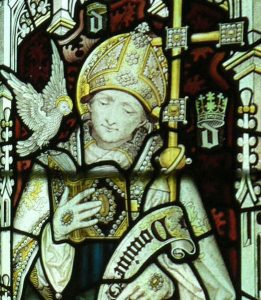Happy St David's Day to all those in Wales or with Welsh blood. Are you wearing a leek or a daffodil today? I'd love to know if you are.
Here is an extract from our Tudor Feast Days e-book on St David's Day...
1st March is the feast day of St David (Dewi Sant), patron saint of Wales. According to Rhigyfarch’s Life of Saint David, David lived in the 6th century and founded religious centres including Glastonbury and Croyland. He then travelled to the Holy Land and was made archbishop at Jerusalem before travelling back to Wales and settling at Glyn Rhosyn (Rose Vale), or St David’s, in Pembrokeshire, Wales. There, he founded a monastery whose site is now marked by St David’s Cathedral.
Dewi (David) and his community were said to have performed many miracles which included Dewi causing the ground to rise beneath him while preaching at the Synod of Llanddewibrefi so that everyone could see him.
Dewi died in 589 and was recognised as a Catholic saint in 1120. His feast day, 1st March, is now no longer a religious feast but is a national celebration of Wales and Welsh identity. It is traditional for Welsh people to wear a daffodil or leek on 1st March, and the leek as a symbol of Wales is linked to two legends:
- The legend of the soldiers of the ancient British king, Cadwaladyr, wearing leeks so that they would know who their comrades were in battle.
- The legend that the Welsh archers fought in a field of leeks at the Battle of Crécy in 1346 when Edward, Prince of Wales, defeated France. It was said that Welshmen then wore leeks on their caps on St David’s Day to remember the courage of the archers.
Steve Roud, in The English Year, points out how William Shakespeare's Henry V (1599), has a scene “in which the English braggart Pistol makes fun of the Welsh captain Fluellen's wearing of a leek on St David's Day, and is forced to eat the vegetable, skin and all.” Roud also writes of how, in the 17th century, Samuel Pepys recorded in his diary for March 1667 the practice of hanging out dolls and scarecrows with leeks on their heads, and calling out after Welshmen “Taffey” or “David” to tease them.
W. Carew Hazlitt, in the book Faith and Folklores, writes of how King Henry VII “having Welsh blood in his veins” felt particularly obliged to observe the feast day and records show that he paid £2 one March for a feast for Welshmen. According to the Privy Purse Expenses of Henry VIII’s daughter, Princess Mary, she was presented with a leek by yeoman of the guard on the feast day in 1537, 1538 and 1544. Here's the record of a payment made to the Yeoman of the Guard in 1544:
“Itm gevin to a yeoman of the garde for bringing a Leeke on saint Davys day - xv s.”
Source: Privy Purse Expenses of the Princess Mary, Daughter of King Henry the Eighth, Afterwards Queen Mary with a Memoir of the Princess and Notes by Frederick Madden, William Pickering, 1831, folio 117.




Leave a Reply